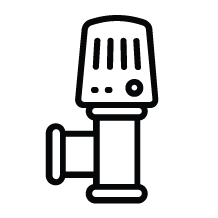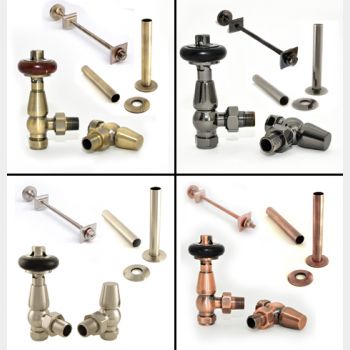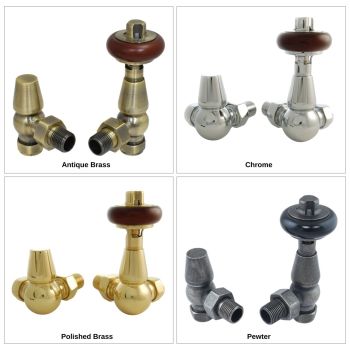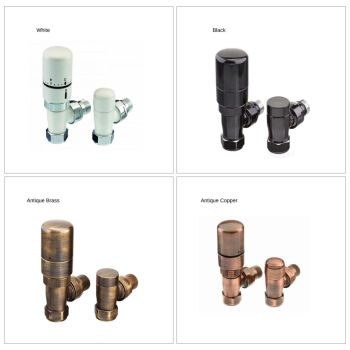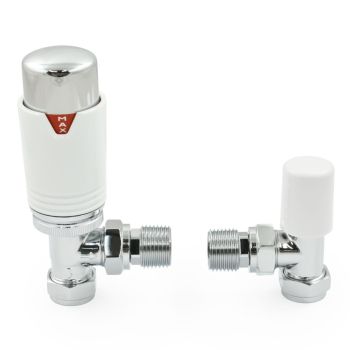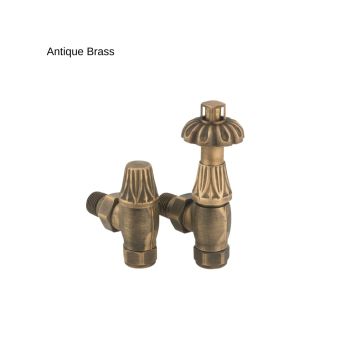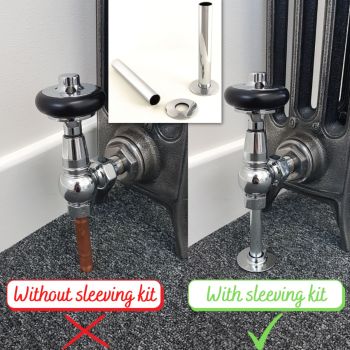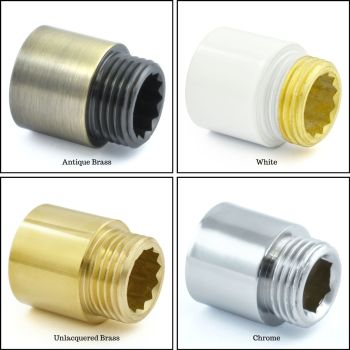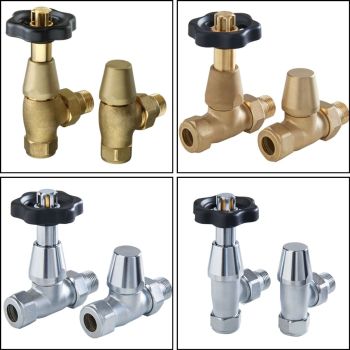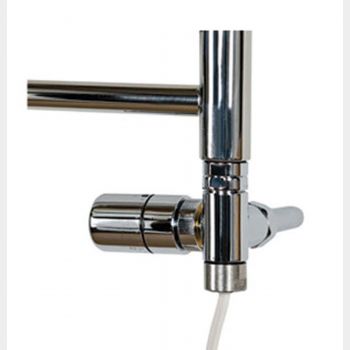100's of finishes to complement your radiator
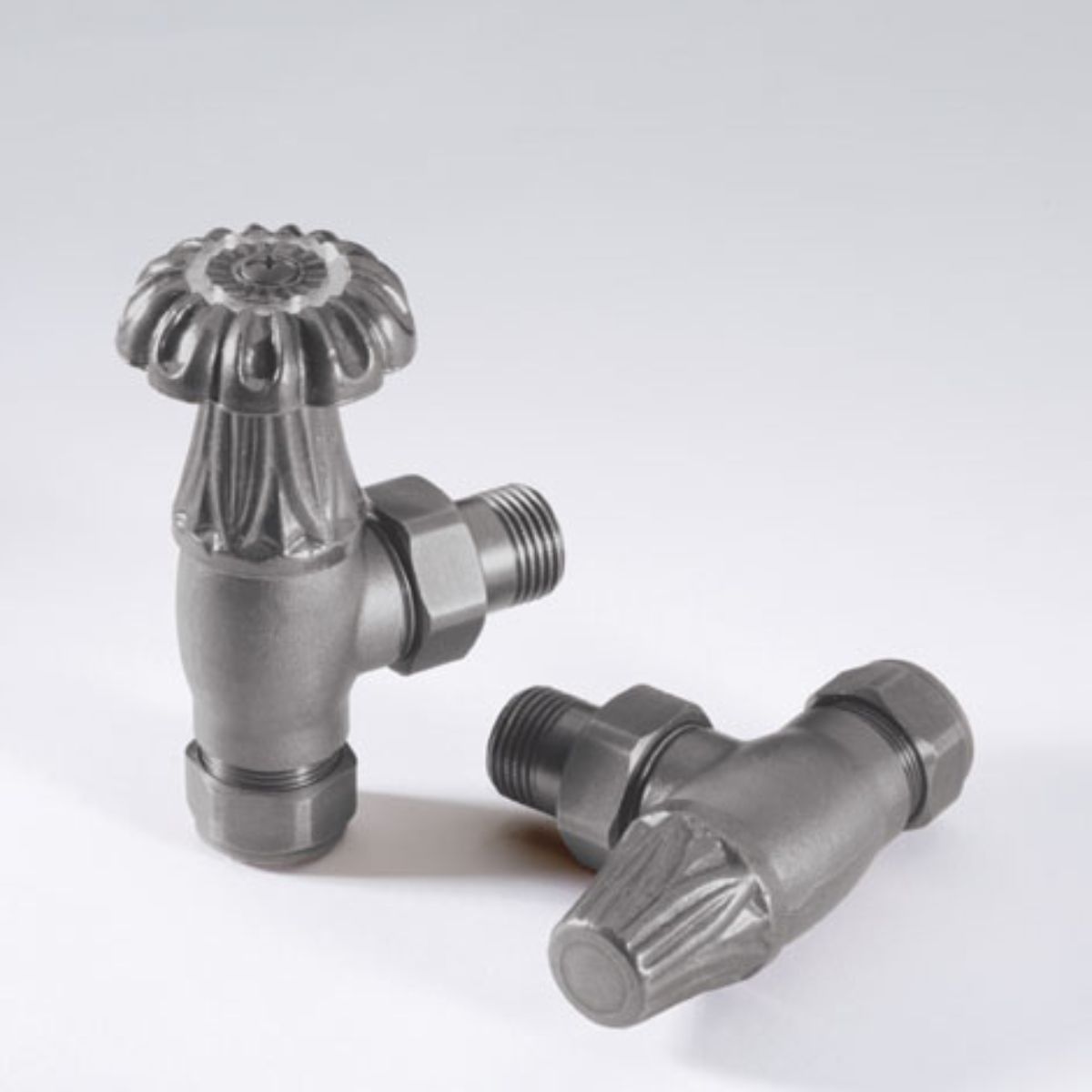
Radiator Valves
Each central heating radiator needs a pair of radiator valves to enable the homeowner to control the heat from each radiator. However standard valves can be ugly and obtrusive so Feature Radiators' has put together a collection of well-designed, top quality manual valves and TRVs to complement your radiator choice(s).
Valve designs range from ornate traditional TRVs for cast iron radiators to simple contemporary manual radiator valves, perfect for towel rails. They come in a range of finishes including chrome, copper, antique brass, satin/brushed and black nickel.
Our radiator valves come in "corner" versions, for the neatest finish if pipes come from the wall, as well as straight and angled. We also sell a range of wall stays/brackets, pipe sleeving kits and other radiator accessories for those finishing touches.
See our YouTube channel for helpful video guides.Feature Radiators' Youtube channel
Prior to any online order being processed, you will be called to check through your order details. Please order with confidence.
Heat Calculator
Calculate My Heat Requirements
FREE UK Delivery
Spend over £100 and get free UK delivery.
Buy With Confidence
Prior to your order being processed we will call you to check details.
Visit Our Showroom
Know what heat output you require? Enter it into the below field and we'll let you know if a radaitor is right for your room.
Not sure what output you need to fill your room with heat? Complete the form below to calculate your required heat output.
My house was built after 2002 or is well insulated (part L compliant)
My room is north facing.
My room has French doors / large window.
My room has single glazed windows.
My room is exposed & colder.

What valves do I need to order to go with my radiator?
You will need one pair of valves for each central heating radiator (electric radiators don’t need valves). We sell valves in pairs – one valve is the temperature control, the other is called a lockshield valve and is used to help “balance” the system.
You will need to decide whether to order manual or thermostatic valves and whether you need straight or angled valves. See below for an explanation, but if in doubt, please call us for help.
Our central heating radiators have standard fittings so any standard valves can be used with them, including those from plumber’s merchants or DIY stores, but be aware that these can be ugly and obtrusive tending to detract from the overall look of the radiator. The devil’s in the detail, so we have put together a collection of good quality stylish valves designed to complement your radiator – see our valves section. We are happy to recommend the best valves for your radiator, just give us a ring.
What are thermostatic valves and what are manual valves and which ones do I need for my radiator?
There are 2 types of valves available, thermostatic and manual. You can use either manual or thermostatic valves on any of our radiators – it’s up to you. The overview below will enable you to make an informed decision when buying radiator valves but if in doubt please ask us. We have also produced a video guide: Guide to Manual or Thermostatic Radiator Valves
Thermostatic Radiator Valves (TRVs) come with an in-built temperature sensor. The thermostatic valve will maintain the room at the temperature you have selected, by automatically adjusting the heat output from the radiator. This means that you can make the most of any “free” heat the room receives, such as that from the sun (solar heat gain) or from electrical appliances. As the valve is controlled automatically, it turns itself on or off, ensuring the radiators perform as efficiently as possible and are environmentally friendly as they prevent energy from being wasted by overheating a room.
Please be aware that building regulations require TRVs to be used for all new builds except:
- For one pair of valves on a system that can and should be manual, so they can be left fully open at all times. This is needed to allow the system to function properly. Usually, such manual valves will be put on the radiator/towel rail in a bathroom or entranceway, as more constant heating is needed in these areas;
In rooms where there is a room thermostat that controls the boiler. - Although not essential, we recommend TRVs for larger radiators (above 1800 watts, or where the radiator is oversized for the room) and for use in kitchens where temperatures can fluctuate dramatically (due to additional heat from ovens, fridges and other appliances).
Manual valves simply act like taps as they directly control the flow of water into the radiator and consequently how hot the radiator gets. Therefore the amount of heat given out will be constant, regardless of the surrounding room temperature. Manual valves allow you to turn the heat up or down, but you will need to physically go to the valve to make the adjustment. Manual valves have no labelled settings – simply turn the valve head until the radiator is giving the amount of heat desired. The smallest most discreet valves available are manual valves.
Whether you choose thermostatic or manual valves is up to you (apart from cases where building regulations apply). As a general rule, thermostatic valves tend to be larger than manual valves (as they need to accommodate the thermostatic mechanism) but are more energy efficient. Manual valves on the other hand, tend to be smaller and more discreet, so are often chosen for their neat minimal look.
If you are still not sure which valves would be best, please ask us.
What is the difference between straight, angled and corner valves?
Below is some helpful advice on which valves we would recommend for different radiator set-ups, enabling you to make an informed decision when buying radiator valves. The “connections” section of our valve brochure illustrates the different variations explained below with helpful images. We have also produced a video guide: Do I need straight, angled or corner radiator valves?
Are your pipes already installed?
You may be starting from scratch without any pipes installed; in this instance, you can probably choose where you want your pipes to come from (wall or floor). This means you have freedom when it comes to choosing your radiator and valves.
However, as is often the case, you may already have your pipework installed. You may be able to have this moved but, if not, this may narrow down your radiator and valve choices.
“Wall-mounted” or “floor-mounted”?
A question we are often asked is whether a particular type of radiator can be “wall-mounted” or “floor-mounted”:
- “Wall-mounted” means that the radiator is hung from the wall on brackets (without feet). However, there is a common misconception among homeowners that “wall-mounted” means that the pipes come out of the wall.
- “Floor-mounted” means that the radiators are sat on the floor, usually on “feet”. Again however customers often think that this means that the pipes come from the floor.
Whether the radiator is hung from a wall or sat on feet, the pipes can come from wherever you need them to; out of the wall, out of the floor, along the skirting board, etc. This position of your pipes does not affect your choice of radiator, but it does affect your choice of the valve.
Position of valve connections?
Side connections
The connections for the valves (holes) are situated at the bottom of the radiator on either side. This is the norm for standard corrugated panel radiators and traditional style cast iron radiators. This type of connection is also known as BBOE or Bottom Bottom Opposite Ends. Remember, in this scenario to add approximately 150mm in total to the width of the radiator to allow space for valves.
Underside connections
The connections for the valves (holes) are situated underneath the radiator, at either end or centrally at 50mm apart. This is the norm for ladder style towel radiators and is common on many modern vertical radiators, which are designed to take up a minimum amount of wall space.
Position of pipes?
Choose your particular set-up from the list below:
- Pipes coming up from the floor on a radiator with side connections = you need “angled” valves
The head of the valves would sit upright, either side of the radiator. - Pipes coming up from the floor on a radiator with underside connections = you need “straight” valves
The valves would sit underneath the radiator and the head of the valves can be twisted so they are in-line with the bottom of the radiator and do not protrude into the room. - Pipes coming out of the wall on a radiator with side connections = you can choose from “angled” or “corner” valves
Traditionally installers would use angled valves, but this means that the valves would lie flat either side of the radiator and the valve heads would stick forward into the room usually beyond the front of the radiator. A neater alternative is to use corner valves, which means that the valves would be either side of the radiator but the heads of the valves would sit upright, rather than protruding into the room. - Pipes coming out of the wall on a radiator with underside connections = you can choose from “angled” or “corner” valves
Traditionally installers would use angled valves, but this means that the valves would sit underneath the radiator and the valve heads would stick forward into the room usually beyond the front of the radiator. A neater alternative is to use corner valves, which means that the valves would sit underneath the radiator and the heads of the valves would sit horizontally, rather than protruding into the room.
Or if you are still confused, give us a ring!


